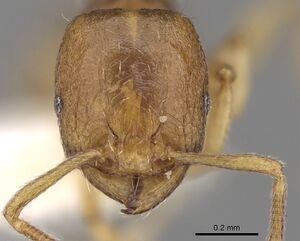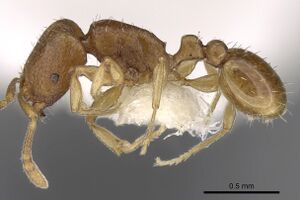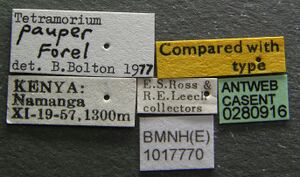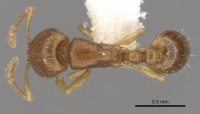Tetramorium pauper
| Tetramorium pauper | |
|---|---|

| |
| Scientific classification | |
| Kingdom: | Animalia |
| Phylum: | Arthropoda |
| Class: | Insecta |
| Order: | Hymenoptera |
| Family: | Formicidae |
| Subfamily: | Myrmicinae |
| Tribe: | Crematogastrini |
| Genus: | Tetramorium |
| Species: | T. pauper |
| Binomial name | |
| Tetramorium pauper Forel, 1907 | |
Known from open to semi-open habitats, e.g., grassland, savannah, and woodland. This is a ground nesting species that has been collected in pitfall traps, leaf-litter, and in the soil.
| At a Glance | • Limited invasive |
Identification
A member of the Tetramorium simillimum species group.
Sharaf et al. (2017) - Worker. Anterior clypeal margin lacking a median notch; frontal carinae very short, ending just behind frontal lobes; antennal scrobes absent; eyes distinctly small with four ommatidia in the longest row; propodeum armed with reduced acute tubercles; cephalic dorsum superficially sculptured; body pilosity short, stout and blunt. Colour uniform yellowish brown or pale brown.
Bolton (1980) - This distinctive minute species is easily separated from its relatives in the poweri-complex of this group by its very small eyes and complete lack of frontal carinae and antennal scrobes. The eyes here are the smallest yet known in the simillimum-group and this is reflected by the fact that in the key pauper runs out with the small-eyed species of the shilohense-group. Its affinities with the simillimum-group are, however, apparent in the reduced propodeal spines and short blunt pilosity.
Keys including this Species
- Key to Afrotropical Tetramorium species groups
- Key to Afrotropical Tetramorium shiloense species group
- Key to Afrotropical Tetramorium simillimum species group
Distribution
Latitudinal Distribution Pattern
Latitudinal Range: 25.45° to -27.1°.
| North Temperate |
North Subtropical |
Tropical | South Subtropical |
South Temperate |
- Source: AntMaps
Distribution based on Regional Taxon Lists
Afrotropical Region: Kenya (type locality), Socotra Archipelago, South Africa, United Republic of Tanzania, Zimbabwe, Zimbabwe.
Distribution based on AntMaps
Distribution based on AntWeb specimens
Check data from AntWeb
Countries Occupied
| Number of countries occupied by this species based on AntWiki Regional Taxon Lists. In general, fewer countries occupied indicates a narrower range, while more countries indicates a more widespread species. |

|
Estimated Abundance
| Relative abundance based on number of AntMaps records per species (this species within the purple bar). Fewer records (to the left) indicates a less abundant/encountered species while more records (to the right) indicates more abundant/encountered species. |

|
Biology
Sharaf et al. (2017) - Tetramorium pauper was found nesting inside a small decayed twig in Yemen. The soil was moist due to irrigation of the date palm orchard. Several workers were nesting under a rock. A nest series was collected from a dry leaf litter next to a date palm tree using a sifting tray.
Hamish Robertson's collection notes include the following:
SAM-HYM-C008689 - Found while excavating other nest. In 2 neat little cells 6 cm below surface. Lowland burnt savanna.. Nest: ground, underground.
SAM-HYM-C008691 - Nest entrance with small turret 8.5mm ext. diam., 2.5mm int. diam, c10mm high. Scatter of soil round base of turret. However, not certain that this entrance belonged to these ants. Ants were in neat little oval cell c 1cm in diam. Lowland burnt savanna.. Habitat: savanna. Nest: ground, underground.
SAM-HYM-C008692 - In cells beneath deeply embedded rock. Rock surrounded by grass. Mountain top grassland with scattered bushes and trees. Habitat: savanna. Nest: ground, under rock.
SAM-HYM-C008752 - Field # 181. ex sifted soil from Camponotus nest excavation. Lowland burnt savanna. Method: sifting soil. Habitat: savanna.
SAM-HYM-C009839 - Found while digging hole in hard soil next to old termite mound under tree. Very common in soil. Numerous cells, widely spaced. Open woodland on slope. Method: digging/chopping through soil.
SAM-HYM-C009849 - ex 1x1 m hole dug in grassland with scattered trees. Soil moist and friable in top 10cm, hard and clay-like lower down. Nest cells at varying depths going down to 30 cm. Method: digging/chopping through soil. Habitat: grassland with scattered trees. Nest site: ground, underground.
Castes
Worker
Images from AntWeb
   
| |
| Worker. Specimen code casent0280916. Photographer Estella Ortega, uploaded by California Academy of Sciences. | Owned by NHMUK, London, UK. |
Nomenclature
The following information is derived from Barry Bolton's Online Catalogue of the Ants of the World.
- pauper. Tetramorium pauper Forel, 1907a: 14 (w.) KENYA. See also: Bolton, 1980: 317.
Unless otherwise noted the text for the remainder of this section is reported from the publication that includes the original description.
Description
Worker
Bolton (1980) - TL 2.0-2.2, HL 0.55-0.60, HW 0.48-0.52, CI 86-89, SL 0.37-0.41, SI 76-83, PW 0.32-0.36, AL 0.58-0.64 (6 measured).
Mandibles smooth with scattered pits and usually also with one or two exceedingly fine striae. Anterior clypeal margin without a median notch, the clypeal median carina distinct. Frontal carinae ending just behind the frontal lobes, well before the level of the eyes. Antennal scrobes absent, the head evenly convex across the space between the eyes. Eyes small, maximum diameter 0.06-0.07, about 0.13-0.15 x HW and with only 4 ommatidia in the longest row; the entire eye with only 10-12 facets altogether. With the head in full-face view it is broadest across the eyes, the sides shallowly convex and converging anteriorly and posteriorly so that the head is distinctly broader at eye-level than at the occipital corners. Propodeum armed with a pair of minute denticles which are much smaller than the metapleural lobes. Petiole narrowing slightly from base to apex and in dorsal view slightly broader than long. Dorsum of head mostly smooth and glossy, with an exceptionally feeble superficial ground-sculpture and sometimes with a few almost effaced vestigial rugulae. Dorsal surfaces of alitrunk with vestigial markings of ground-sculpture which are almost completely effaced, the pedicel segments and gaster smooth dorsally. All dorsal surfaces of head and body sparsely covered with short, stout, blunt hairs, most of which are shorter than the maximum diameter of the eye but a few longer hairs are present on the anterior pronotum, the pedicel segments and the gaster. Hind tibiae only having minute decumbent or appressed pubescence. Colour uniform yellowish brown or light brown.
Type Material
Bolton (1980) - Holotype worker, Kenya: Mto-ya-Kifaru (Katona) (Musee d'Histoire Naturelle Genève) [examined].
References
- Bolton, B. 1980. The ant tribe Tetramoriini (Hymenoptera: Formicidae). The genus Tetramorium Mayr in the Ethiopian zoogeographical region. Bulletin of the British Museum (Natural History) Entomology. 40(3):193-384.
- Arnold, G. 1917. A monograph of the Formicidae of South Africa. Part III. Myrmicinae. Ann. S. Afr. Mus. 14: 271-402 (page 332, Replacement name: ericae)
- Bolton, B. 1995b. A new general catalogue of the ants of the world. Cambridge, Mass.: Harvard University Press, 504 pp. (page 407, [Junior synonym of pauper Santschi, hence first available replacement name.)
- Borowiec, L. 2014. Catalogue of ants of Europe, the Mediterranean Basin and adjacent regions (Hymenoptera: Formicidae). Genus (Wroclaw) 25(1-2): 1-340.
- Forel, A. 1907d. Formicides du Musée National Hongrois. Ann. Hist.-Nat. Mus. Natl. Hung. 5: 1-42 (page 14, worker described)
- Santschi, F. 1917b [1916]. Fourmis nouvelles de la Colonie du Cap, du Natal et de Rhodesia. Ann. Soc. Entomol. Fr. 85: 279-296 (page 286, Tetramorium)
- Sharaf, M.R., Fisher, B.L., Collingwood, C.A., Aldawood, A.S. 2017. Ant fauna (Hymenoptera: Formicidae) of the Socotra Archipelago (Yemen): zoogeography, distribution and description of a new species. Journal of Natural History 51, 317–378 (DOI 10.1080/00222933.2016.1271157).
References based on Global Ant Biodiversity Informatics
- Bolton B. 1980. The ant tribe Tetramoriini (Hymenoptera: Formicidae). The genus Tetramorium Mayr in the Ethiopian zoogeographical region. Bulletin of the British Museum (Natural History). Entomology 40: 193-384.
- IZIKO South Africa Museum Collection
- Samways M. J. 1990. Species temporal variability: epigaeic ant assemblages and management for abundance and scarcity. Oecologia 84: 482-490.

